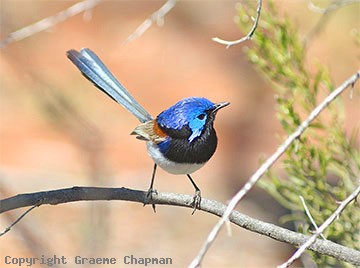
Malurus lamberti
TAXONOMY
Malurus lamberti Vigors and Horsefield, 1827, Sydney, New
South Wales, Australia. Five subspecies.
OTHER COMMON NAMES
English: Variegated wren; French: Mйrion de Lambert; German:
Weissbauch-Staffelschwanz; Spanish: Ratona Australiana
Variada.
PHYSICAL CHARACTERISTICS
5.5 in (14 cm); female 0.21–0.35 oz (5.9–10 g), male 0.21–0.41
oz (6.0–11.5 g). Breeding male with black throat and breast,
russet back, and turquoise mantle, cap, and cheeks; whitetipped
blue tail. Nonbreeding males, females, and immatures
with blue heads and backs, white below.
DISTRIBUTION
Widely distributed across Australia. M. l. assimilis found
throughout Australia except for southwest, southeast, and far
north; M. l. rogersi in Kimberley Division, M. l. dulcis in Arnhem
Land, M. l. lamberti in coastal southern Queensland and
New South Wales, and M. l. bernieri is restricted to islands off
Shark Bay in Western Australia.
HABITAT
A broad spectrum of habitats: in shrubby vegetation from
coastal thickets through arid and semi-arid acacia woodlands
and scrub; also, rocky escarpments and mallee.
BEHAVIOR
A weak flier that forages from ground to canopy by hopping.
Group territorial defense throughout the year. Voice a fast,
metallic trill.
FEEDING ECOLOGY AND DIET
Forages by gleaning on low shrubbery. Takes a broad spectrum
of invertebrates including flies, caterpillars, grasshoppers,
and spiders. May forage in canopy or on open ground.
REPRODUCTIVE BIOLOGY
Monogamous cooperative breeder, but probably promiscuous.
Clutch is three or four red/brown-spotted, white eggs. Female
incubates for 14–16 days; fledging in 10–12 days.
CONSERVATION STATUS
Widespread and not threatened, although adversely affected by
clearing of habitat for agriculture, and by overgrazing.
SIGNIFICANCE TO HUMANS
None known.
Other popular Animals
Photo Gallery of - Variegated fairy-wren




 Animalia Life
Animalia Life